Financial Reporting Analysis of The Star Ent Group (ACCT20074)
VerifiedAdded on 2023/04/04
|29
|5339
|272
Report
AI Summary
This report provides an in-depth analysis of The Star Ent Group's corporate external reporting practices, focusing on its use of the Conceptual Framework for Financial Reporting. The report begins with a review of the framework's history and development, highlighting the concerns of the Australian accounting profession regarding its application, and discusses the potential benefits and limitations. The report then examines the financial statements prepared by The Star Ent Group, including the consolidated income statement, balance sheet, cash flow statement, statement of equity changes and segment information, and the application of recognition principles and measurement bases for revenue, assets, and liabilities. The report references the conceptual framework and its application within the company's financial reporting practices. The report also compares the company's approach to that of another company in South Africa. The report covers the financial statements prepared by the company and how the conceptual framework is used to achieve the objective of financial reporting.
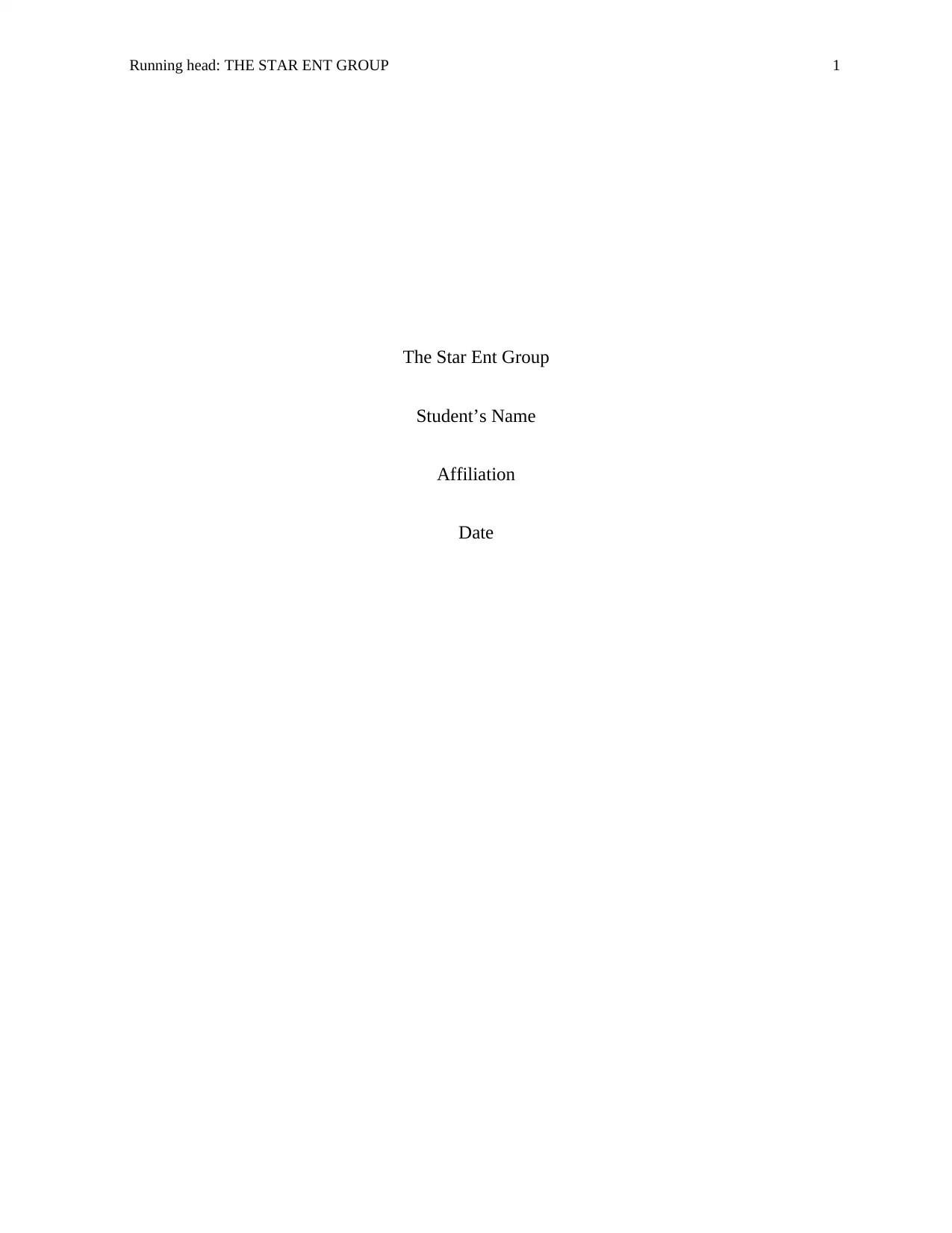
Running head: THE STAR ENT GROUP 1
The Star Ent Group
Student’s Name
Affiliation
Date
The Star Ent Group
Student’s Name
Affiliation
Date
Paraphrase This Document
Need a fresh take? Get an instant paraphrase of this document with our AI Paraphraser
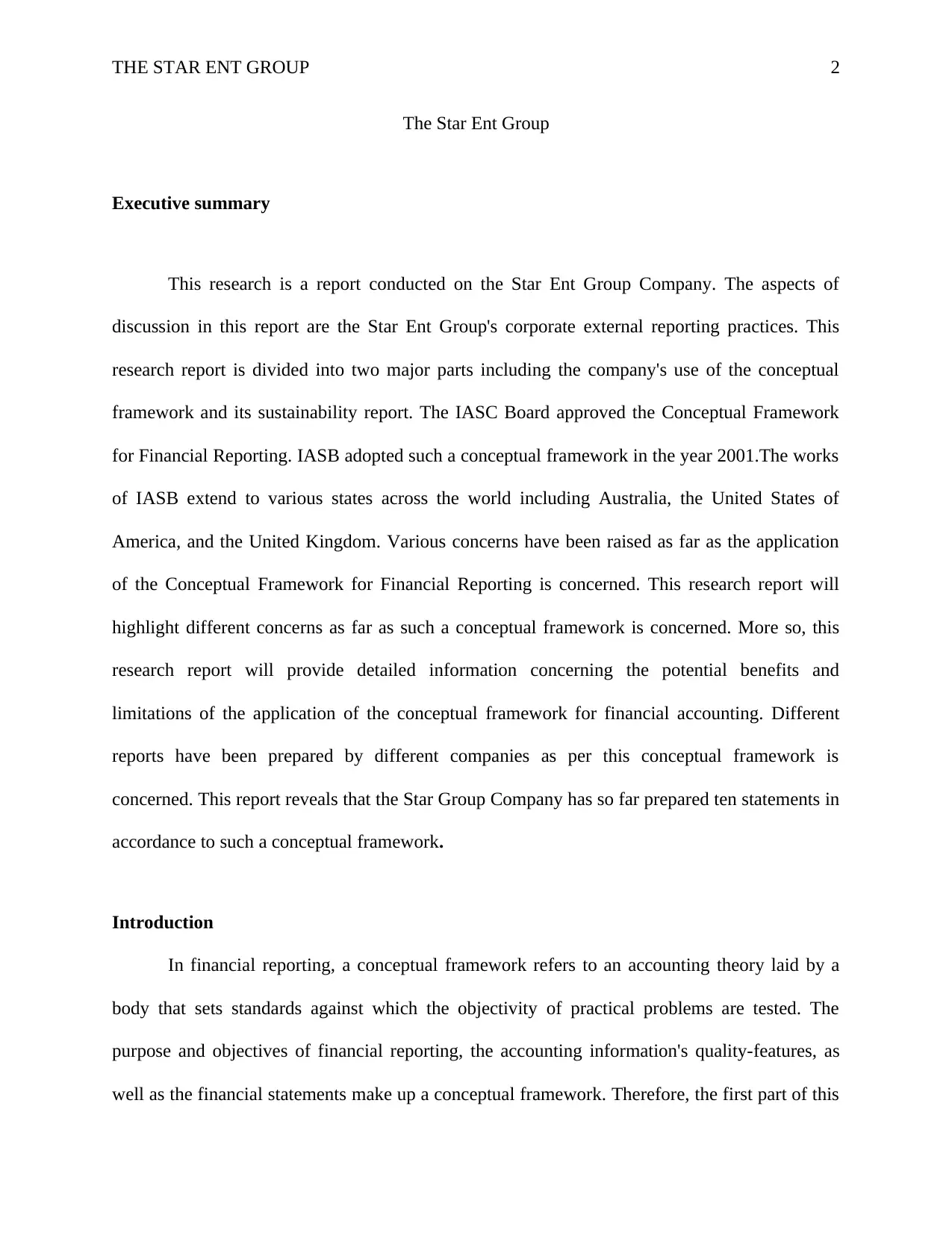
THE STAR ENT GROUP 2
The Star Ent Group
Executive summary
This research is a report conducted on the Star Ent Group Company. The aspects of
discussion in this report are the Star Ent Group's corporate external reporting practices. This
research report is divided into two major parts including the company's use of the conceptual
framework and its sustainability report. The IASC Board approved the Conceptual Framework
for Financial Reporting. IASB adopted such a conceptual framework in the year 2001.The works
of IASB extend to various states across the world including Australia, the United States of
America, and the United Kingdom. Various concerns have been raised as far as the application
of the Conceptual Framework for Financial Reporting is concerned. This research report will
highlight different concerns as far as such a conceptual framework is concerned. More so, this
research report will provide detailed information concerning the potential benefits and
limitations of the application of the conceptual framework for financial accounting. Different
reports have been prepared by different companies as per this conceptual framework is
concerned. This report reveals that the Star Group Company has so far prepared ten statements in
accordance to such a conceptual framework.
Introduction
In financial reporting, a conceptual framework refers to an accounting theory laid by a
body that sets standards against which the objectivity of practical problems are tested. The
purpose and objectives of financial reporting, the accounting information's quality-features, as
well as the financial statements make up a conceptual framework. Therefore, the first part of this
The Star Ent Group
Executive summary
This research is a report conducted on the Star Ent Group Company. The aspects of
discussion in this report are the Star Ent Group's corporate external reporting practices. This
research report is divided into two major parts including the company's use of the conceptual
framework and its sustainability report. The IASC Board approved the Conceptual Framework
for Financial Reporting. IASB adopted such a conceptual framework in the year 2001.The works
of IASB extend to various states across the world including Australia, the United States of
America, and the United Kingdom. Various concerns have been raised as far as the application
of the Conceptual Framework for Financial Reporting is concerned. This research report will
highlight different concerns as far as such a conceptual framework is concerned. More so, this
research report will provide detailed information concerning the potential benefits and
limitations of the application of the conceptual framework for financial accounting. Different
reports have been prepared by different companies as per this conceptual framework is
concerned. This report reveals that the Star Group Company has so far prepared ten statements in
accordance to such a conceptual framework.
Introduction
In financial reporting, a conceptual framework refers to an accounting theory laid by a
body that sets standards against which the objectivity of practical problems are tested. The
purpose and objectives of financial reporting, the accounting information's quality-features, as
well as the financial statements make up a conceptual framework. Therefore, the first part of this
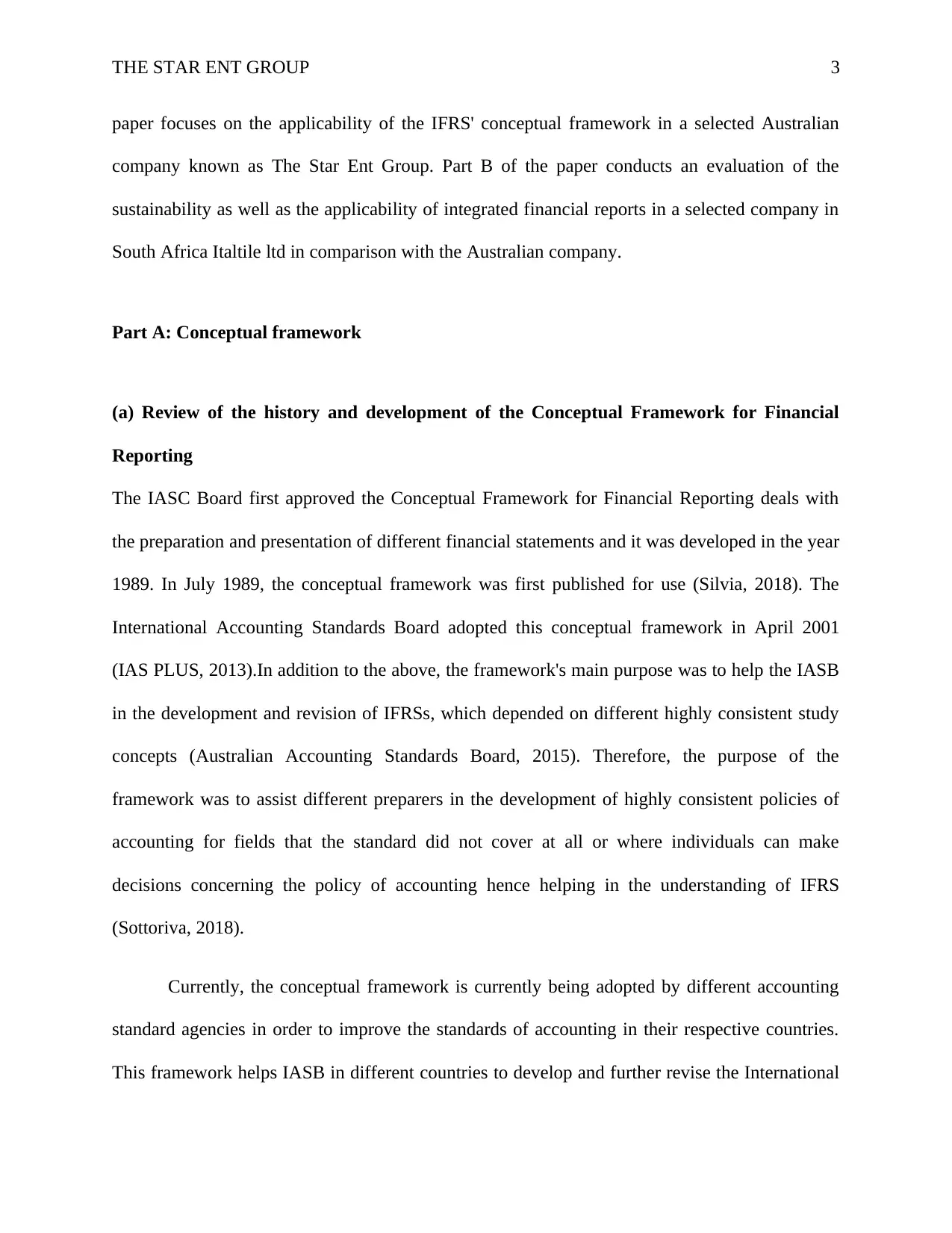
THE STAR ENT GROUP 3
paper focuses on the applicability of the IFRS' conceptual framework in a selected Australian
company known as The Star Ent Group. Part B of the paper conducts an evaluation of the
sustainability as well as the applicability of integrated financial reports in a selected company in
South Africa Italtile ltd in comparison with the Australian company.
Part A: Conceptual framework
(a) Review of the history and development of the Conceptual Framework for Financial
Reporting
The IASC Board first approved the Conceptual Framework for Financial Reporting deals with
the preparation and presentation of different financial statements and it was developed in the year
1989. In July 1989, the conceptual framework was first published for use (Silvia, 2018). The
International Accounting Standards Board adopted this conceptual framework in April 2001
(IAS PLUS, 2013).In addition to the above, the framework's main purpose was to help the IASB
in the development and revision of IFRSs, which depended on different highly consistent study
concepts (Australian Accounting Standards Board, 2015). Therefore, the purpose of the
framework was to assist different preparers in the development of highly consistent policies of
accounting for fields that the standard did not cover at all or where individuals can make
decisions concerning the policy of accounting hence helping in the understanding of IFRS
(Sottoriva, 2018).
Currently, the conceptual framework is currently being adopted by different accounting
standard agencies in order to improve the standards of accounting in their respective countries.
This framework helps IASB in different countries to develop and further revise the International
paper focuses on the applicability of the IFRS' conceptual framework in a selected Australian
company known as The Star Ent Group. Part B of the paper conducts an evaluation of the
sustainability as well as the applicability of integrated financial reports in a selected company in
South Africa Italtile ltd in comparison with the Australian company.
Part A: Conceptual framework
(a) Review of the history and development of the Conceptual Framework for Financial
Reporting
The IASC Board first approved the Conceptual Framework for Financial Reporting deals with
the preparation and presentation of different financial statements and it was developed in the year
1989. In July 1989, the conceptual framework was first published for use (Silvia, 2018). The
International Accounting Standards Board adopted this conceptual framework in April 2001
(IAS PLUS, 2013).In addition to the above, the framework's main purpose was to help the IASB
in the development and revision of IFRSs, which depended on different highly consistent study
concepts (Australian Accounting Standards Board, 2015). Therefore, the purpose of the
framework was to assist different preparers in the development of highly consistent policies of
accounting for fields that the standard did not cover at all or where individuals can make
decisions concerning the policy of accounting hence helping in the understanding of IFRS
(Sottoriva, 2018).
Currently, the conceptual framework is currently being adopted by different accounting
standard agencies in order to improve the standards of accounting in their respective countries.
This framework helps IASB in different countries to develop and further revise the International
⊘ This is a preview!⊘
Do you want full access?
Subscribe today to unlock all pages.

Trusted by 1+ million students worldwide
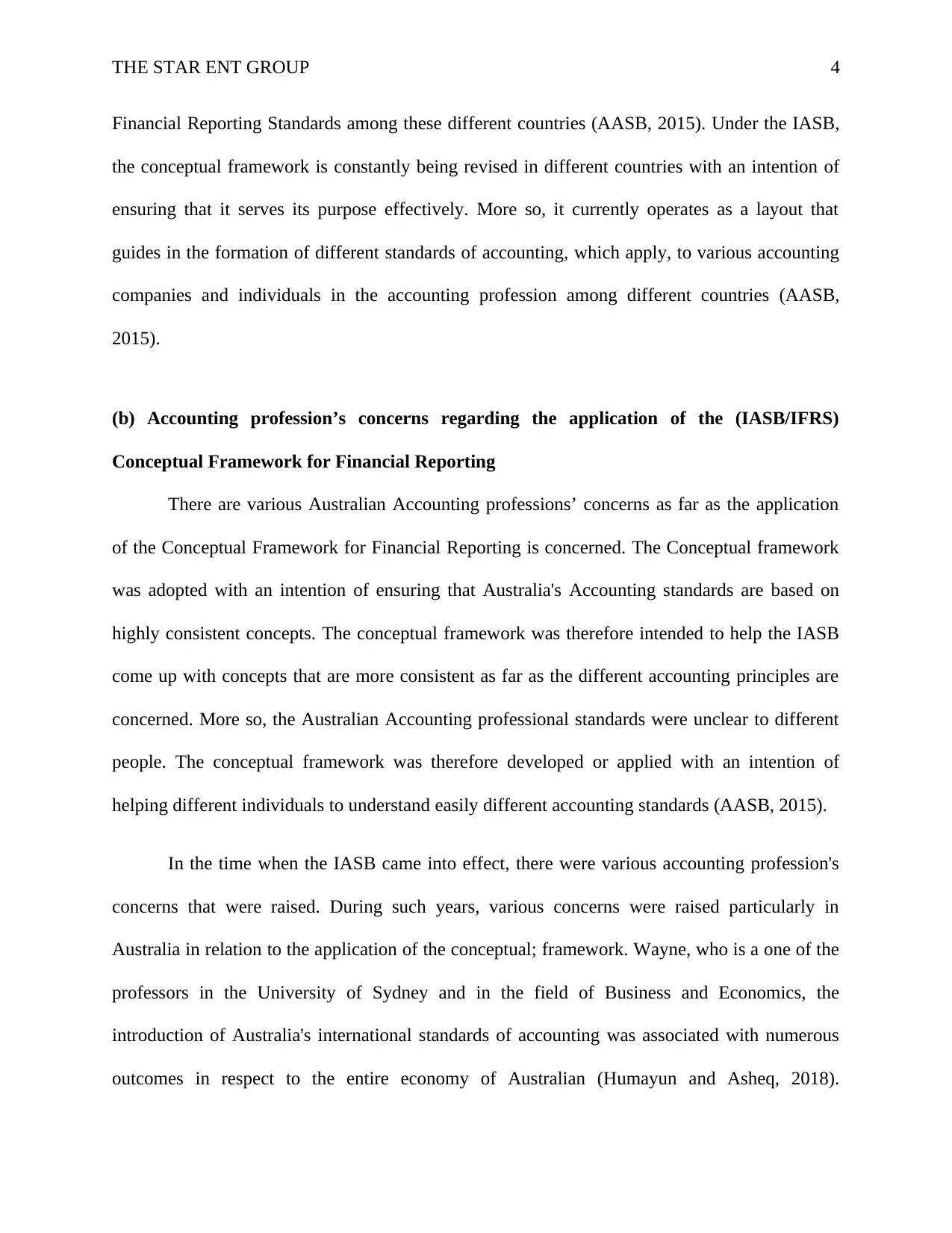
THE STAR ENT GROUP 4
Financial Reporting Standards among these different countries (AASB, 2015). Under the IASB,
the conceptual framework is constantly being revised in different countries with an intention of
ensuring that it serves its purpose effectively. More so, it currently operates as a layout that
guides in the formation of different standards of accounting, which apply, to various accounting
companies and individuals in the accounting profession among different countries (AASB,
2015).
(b) Accounting profession’s concerns regarding the application of the (IASB/IFRS)
Conceptual Framework for Financial Reporting
There are various Australian Accounting professions’ concerns as far as the application
of the Conceptual Framework for Financial Reporting is concerned. The Conceptual framework
was adopted with an intention of ensuring that Australia's Accounting standards are based on
highly consistent concepts. The conceptual framework was therefore intended to help the IASB
come up with concepts that are more consistent as far as the different accounting principles are
concerned. More so, the Australian Accounting professional standards were unclear to different
people. The conceptual framework was therefore developed or applied with an intention of
helping different individuals to understand easily different accounting standards (AASB, 2015).
In the time when the IASB came into effect, there were various accounting profession's
concerns that were raised. During such years, various concerns were raised particularly in
Australia in relation to the application of the conceptual; framework. Wayne, who is a one of the
professors in the University of Sydney and in the field of Business and Economics, the
introduction of Australia's international standards of accounting was associated with numerous
outcomes in respect to the entire economy of Australian (Humayun and Asheq, 2018).
Financial Reporting Standards among these different countries (AASB, 2015). Under the IASB,
the conceptual framework is constantly being revised in different countries with an intention of
ensuring that it serves its purpose effectively. More so, it currently operates as a layout that
guides in the formation of different standards of accounting, which apply, to various accounting
companies and individuals in the accounting profession among different countries (AASB,
2015).
(b) Accounting profession’s concerns regarding the application of the (IASB/IFRS)
Conceptual Framework for Financial Reporting
There are various Australian Accounting professions’ concerns as far as the application
of the Conceptual Framework for Financial Reporting is concerned. The Conceptual framework
was adopted with an intention of ensuring that Australia's Accounting standards are based on
highly consistent concepts. The conceptual framework was therefore intended to help the IASB
come up with concepts that are more consistent as far as the different accounting principles are
concerned. More so, the Australian Accounting professional standards were unclear to different
people. The conceptual framework was therefore developed or applied with an intention of
helping different individuals to understand easily different accounting standards (AASB, 2015).
In the time when the IASB came into effect, there were various accounting profession's
concerns that were raised. During such years, various concerns were raised particularly in
Australia in relation to the application of the conceptual; framework. Wayne, who is a one of the
professors in the University of Sydney and in the field of Business and Economics, the
introduction of Australia's international standards of accounting was associated with numerous
outcomes in respect to the entire economy of Australian (Humayun and Asheq, 2018).
Paraphrase This Document
Need a fresh take? Get an instant paraphrase of this document with our AI Paraphraser
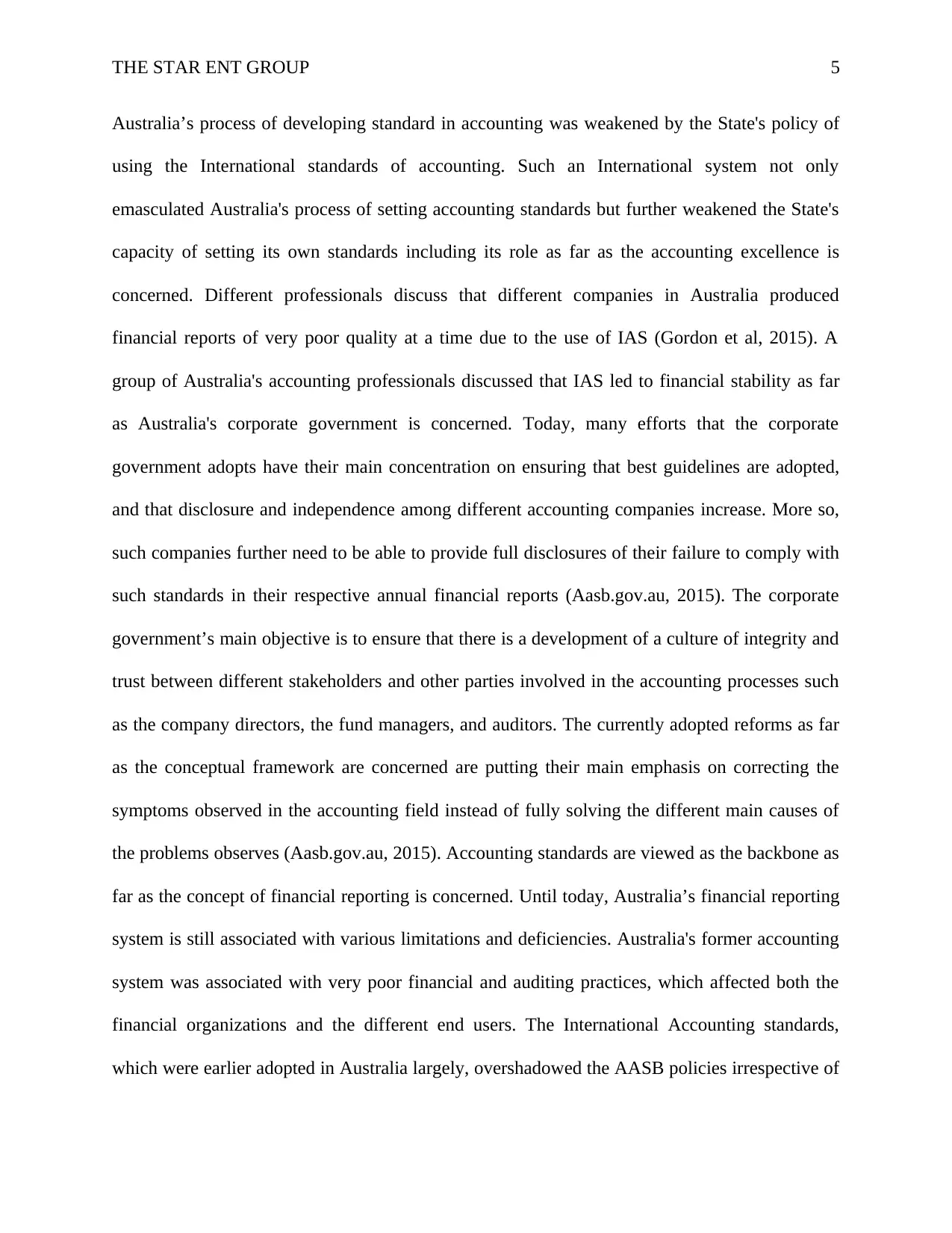
THE STAR ENT GROUP 5
Australia’s process of developing standard in accounting was weakened by the State's policy of
using the International standards of accounting. Such an International system not only
emasculated Australia's process of setting accounting standards but further weakened the State's
capacity of setting its own standards including its role as far as the accounting excellence is
concerned. Different professionals discuss that different companies in Australia produced
financial reports of very poor quality at a time due to the use of IAS (Gordon et al, 2015). A
group of Australia's accounting professionals discussed that IAS led to financial stability as far
as Australia's corporate government is concerned. Today, many efforts that the corporate
government adopts have their main concentration on ensuring that best guidelines are adopted,
and that disclosure and independence among different accounting companies increase. More so,
such companies further need to be able to provide full disclosures of their failure to comply with
such standards in their respective annual financial reports (Aasb.gov.au, 2015). The corporate
government’s main objective is to ensure that there is a development of a culture of integrity and
trust between different stakeholders and other parties involved in the accounting processes such
as the company directors, the fund managers, and auditors. The currently adopted reforms as far
as the conceptual framework are concerned are putting their main emphasis on correcting the
symptoms observed in the accounting field instead of fully solving the different main causes of
the problems observes (Aasb.gov.au, 2015). Accounting standards are viewed as the backbone as
far as the concept of financial reporting is concerned. Until today, Australia’s financial reporting
system is still associated with various limitations and deficiencies. Australia's former accounting
system was associated with very poor financial and auditing practices, which affected both the
financial organizations and the different end users. The International Accounting standards,
which were earlier adopted in Australia largely, overshadowed the AASB policies irrespective of
Australia’s process of developing standard in accounting was weakened by the State's policy of
using the International standards of accounting. Such an International system not only
emasculated Australia's process of setting accounting standards but further weakened the State's
capacity of setting its own standards including its role as far as the accounting excellence is
concerned. Different professionals discuss that different companies in Australia produced
financial reports of very poor quality at a time due to the use of IAS (Gordon et al, 2015). A
group of Australia's accounting professionals discussed that IAS led to financial stability as far
as Australia's corporate government is concerned. Today, many efforts that the corporate
government adopts have their main concentration on ensuring that best guidelines are adopted,
and that disclosure and independence among different accounting companies increase. More so,
such companies further need to be able to provide full disclosures of their failure to comply with
such standards in their respective annual financial reports (Aasb.gov.au, 2015). The corporate
government’s main objective is to ensure that there is a development of a culture of integrity and
trust between different stakeholders and other parties involved in the accounting processes such
as the company directors, the fund managers, and auditors. The currently adopted reforms as far
as the conceptual framework are concerned are putting their main emphasis on correcting the
symptoms observed in the accounting field instead of fully solving the different main causes of
the problems observes (Aasb.gov.au, 2015). Accounting standards are viewed as the backbone as
far as the concept of financial reporting is concerned. Until today, Australia’s financial reporting
system is still associated with various limitations and deficiencies. Australia's former accounting
system was associated with very poor financial and auditing practices, which affected both the
financial organizations and the different end users. The International Accounting standards,
which were earlier adopted in Australia largely, overshadowed the AASB policies irrespective of
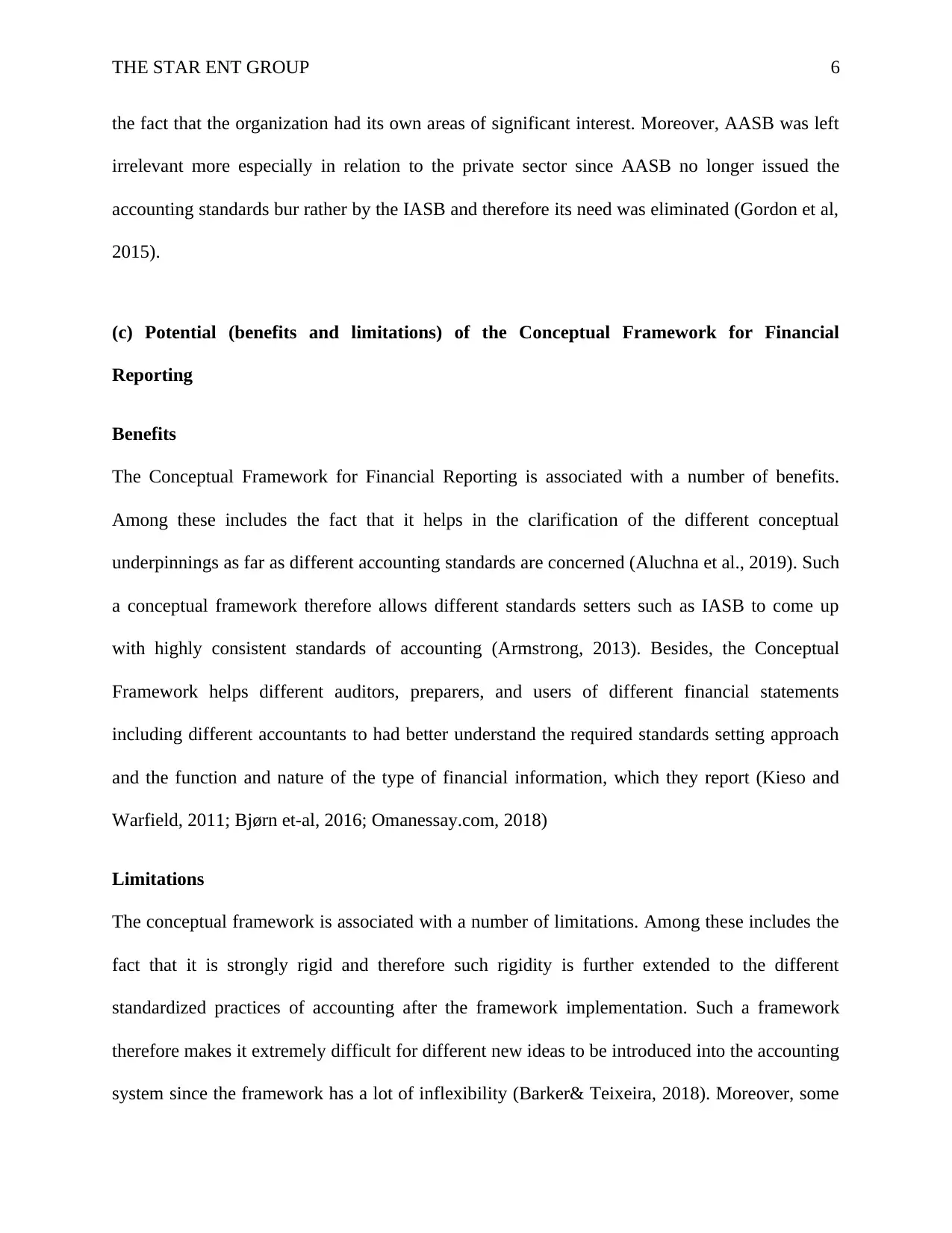
THE STAR ENT GROUP 6
the fact that the organization had its own areas of significant interest. Moreover, AASB was left
irrelevant more especially in relation to the private sector since AASB no longer issued the
accounting standards bur rather by the IASB and therefore its need was eliminated (Gordon et al,
2015).
(c) Potential (benefits and limitations) of the Conceptual Framework for Financial
Reporting
Benefits
The Conceptual Framework for Financial Reporting is associated with a number of benefits.
Among these includes the fact that it helps in the clarification of the different conceptual
underpinnings as far as different accounting standards are concerned (Aluchna et al., 2019). Such
a conceptual framework therefore allows different standards setters such as IASB to come up
with highly consistent standards of accounting (Armstrong, 2013). Besides, the Conceptual
Framework helps different auditors, preparers, and users of different financial statements
including different accountants to had better understand the required standards setting approach
and the function and nature of the type of financial information, which they report (Kieso and
Warfield, 2011; Bjørn et-al, 2016; Omanessay.com, 2018)
Limitations
The conceptual framework is associated with a number of limitations. Among these includes the
fact that it is strongly rigid and therefore such rigidity is further extended to the different
standardized practices of accounting after the framework implementation. Such a framework
therefore makes it extremely difficult for different new ideas to be introduced into the accounting
system since the framework has a lot of inflexibility (Barker& Teixeira, 2018). Moreover, some
the fact that the organization had its own areas of significant interest. Moreover, AASB was left
irrelevant more especially in relation to the private sector since AASB no longer issued the
accounting standards bur rather by the IASB and therefore its need was eliminated (Gordon et al,
2015).
(c) Potential (benefits and limitations) of the Conceptual Framework for Financial
Reporting
Benefits
The Conceptual Framework for Financial Reporting is associated with a number of benefits.
Among these includes the fact that it helps in the clarification of the different conceptual
underpinnings as far as different accounting standards are concerned (Aluchna et al., 2019). Such
a conceptual framework therefore allows different standards setters such as IASB to come up
with highly consistent standards of accounting (Armstrong, 2013). Besides, the Conceptual
Framework helps different auditors, preparers, and users of different financial statements
including different accountants to had better understand the required standards setting approach
and the function and nature of the type of financial information, which they report (Kieso and
Warfield, 2011; Bjørn et-al, 2016; Omanessay.com, 2018)
Limitations
The conceptual framework is associated with a number of limitations. Among these includes the
fact that it is strongly rigid and therefore such rigidity is further extended to the different
standardized practices of accounting after the framework implementation. Such a framework
therefore makes it extremely difficult for different new ideas to be introduced into the accounting
system since the framework has a lot of inflexibility (Barker& Teixeira, 2018). Moreover, some
⊘ This is a preview!⊘
Do you want full access?
Subscribe today to unlock all pages.

Trusted by 1+ million students worldwide
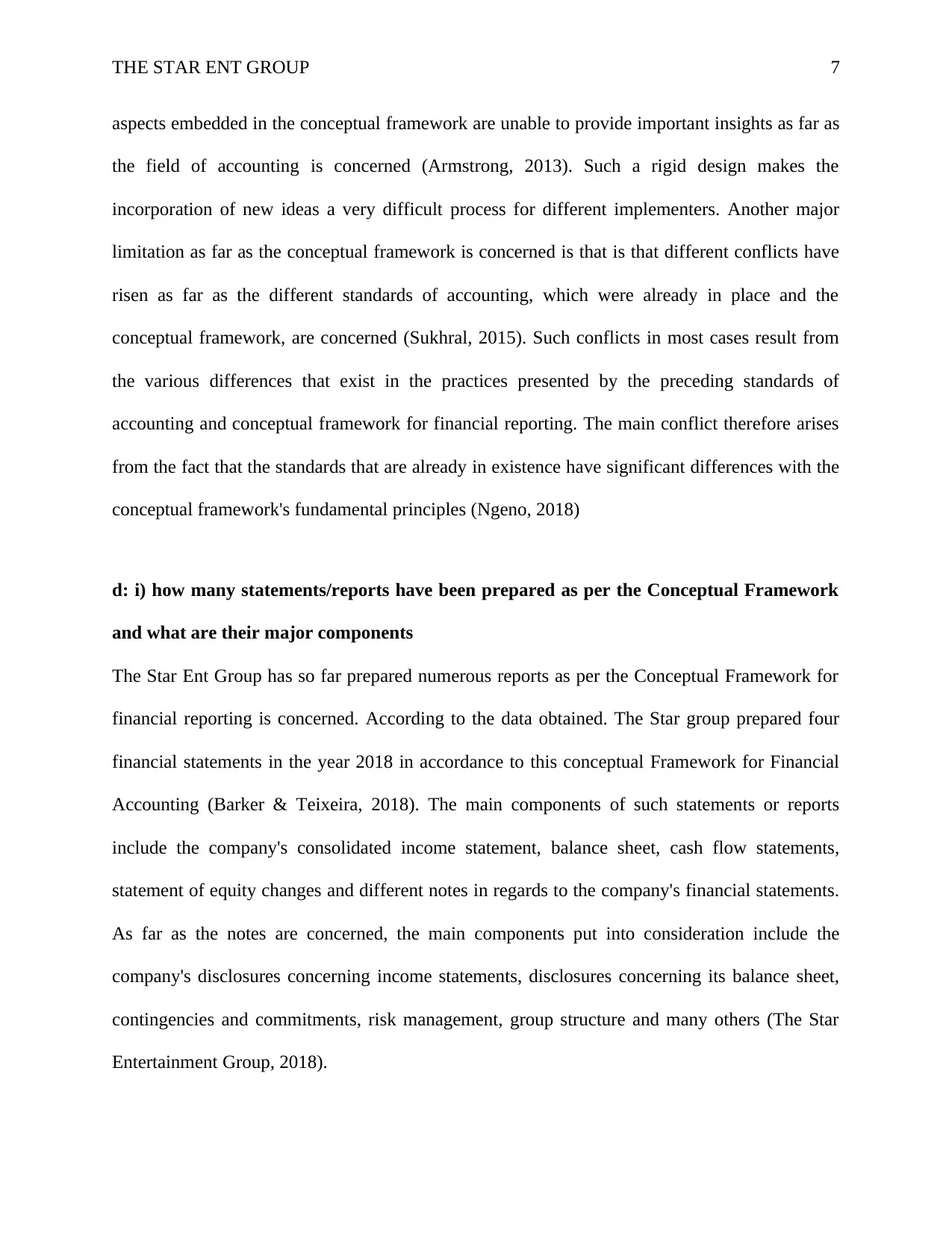
THE STAR ENT GROUP 7
aspects embedded in the conceptual framework are unable to provide important insights as far as
the field of accounting is concerned (Armstrong, 2013). Such a rigid design makes the
incorporation of new ideas a very difficult process for different implementers. Another major
limitation as far as the conceptual framework is concerned is that is that different conflicts have
risen as far as the different standards of accounting, which were already in place and the
conceptual framework, are concerned (Sukhral, 2015). Such conflicts in most cases result from
the various differences that exist in the practices presented by the preceding standards of
accounting and conceptual framework for financial reporting. The main conflict therefore arises
from the fact that the standards that are already in existence have significant differences with the
conceptual framework's fundamental principles (Ngeno, 2018)
d: i) how many statements/reports have been prepared as per the Conceptual Framework
and what are their major components
The Star Ent Group has so far prepared numerous reports as per the Conceptual Framework for
financial reporting is concerned. According to the data obtained. The Star group prepared four
financial statements in the year 2018 in accordance to this conceptual Framework for Financial
Accounting (Barker & Teixeira, 2018). The main components of such statements or reports
include the company's consolidated income statement, balance sheet, cash flow statements,
statement of equity changes and different notes in regards to the company's financial statements.
As far as the notes are concerned, the main components put into consideration include the
company's disclosures concerning income statements, disclosures concerning its balance sheet,
contingencies and commitments, risk management, group structure and many others (The Star
Entertainment Group, 2018).
aspects embedded in the conceptual framework are unable to provide important insights as far as
the field of accounting is concerned (Armstrong, 2013). Such a rigid design makes the
incorporation of new ideas a very difficult process for different implementers. Another major
limitation as far as the conceptual framework is concerned is that is that different conflicts have
risen as far as the different standards of accounting, which were already in place and the
conceptual framework, are concerned (Sukhral, 2015). Such conflicts in most cases result from
the various differences that exist in the practices presented by the preceding standards of
accounting and conceptual framework for financial reporting. The main conflict therefore arises
from the fact that the standards that are already in existence have significant differences with the
conceptual framework's fundamental principles (Ngeno, 2018)
d: i) how many statements/reports have been prepared as per the Conceptual Framework
and what are their major components
The Star Ent Group has so far prepared numerous reports as per the Conceptual Framework for
financial reporting is concerned. According to the data obtained. The Star group prepared four
financial statements in the year 2018 in accordance to this conceptual Framework for Financial
Accounting (Barker & Teixeira, 2018). The main components of such statements or reports
include the company's consolidated income statement, balance sheet, cash flow statements,
statement of equity changes and different notes in regards to the company's financial statements.
As far as the notes are concerned, the main components put into consideration include the
company's disclosures concerning income statements, disclosures concerning its balance sheet,
contingencies and commitments, risk management, group structure and many others (The Star
Entertainment Group, 2018).
Paraphrase This Document
Need a fresh take? Get an instant paraphrase of this document with our AI Paraphraser
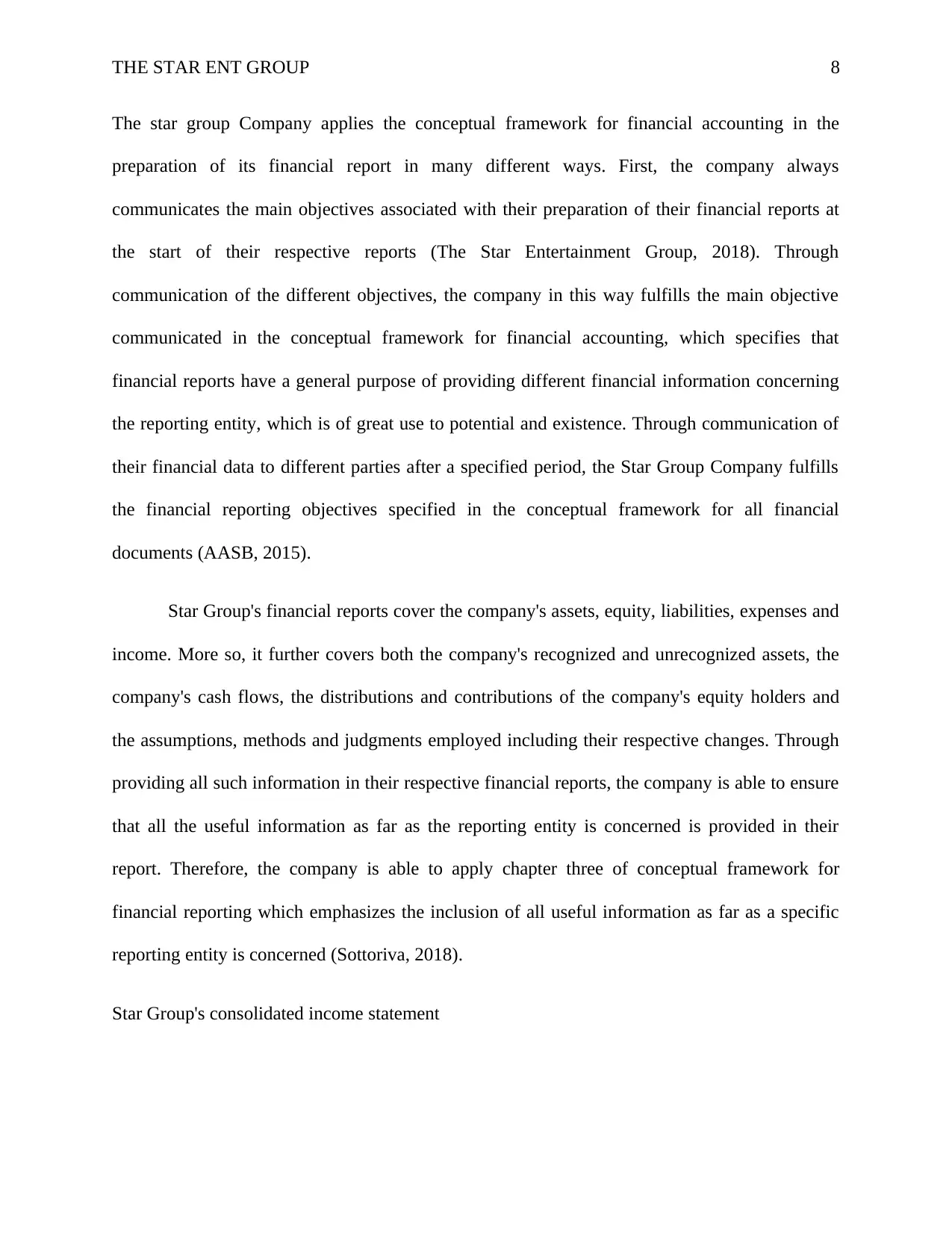
THE STAR ENT GROUP 8
The star group Company applies the conceptual framework for financial accounting in the
preparation of its financial report in many different ways. First, the company always
communicates the main objectives associated with their preparation of their financial reports at
the start of their respective reports (The Star Entertainment Group, 2018). Through
communication of the different objectives, the company in this way fulfills the main objective
communicated in the conceptual framework for financial accounting, which specifies that
financial reports have a general purpose of providing different financial information concerning
the reporting entity, which is of great use to potential and existence. Through communication of
their financial data to different parties after a specified period, the Star Group Company fulfills
the financial reporting objectives specified in the conceptual framework for all financial
documents (AASB, 2015).
Star Group's financial reports cover the company's assets, equity, liabilities, expenses and
income. More so, it further covers both the company's recognized and unrecognized assets, the
company's cash flows, the distributions and contributions of the company's equity holders and
the assumptions, methods and judgments employed including their respective changes. Through
providing all such information in their respective financial reports, the company is able to ensure
that all the useful information as far as the reporting entity is concerned is provided in their
report. Therefore, the company is able to apply chapter three of conceptual framework for
financial reporting which emphasizes the inclusion of all useful information as far as a specific
reporting entity is concerned (Sottoriva, 2018).
Star Group's consolidated income statement
The star group Company applies the conceptual framework for financial accounting in the
preparation of its financial report in many different ways. First, the company always
communicates the main objectives associated with their preparation of their financial reports at
the start of their respective reports (The Star Entertainment Group, 2018). Through
communication of the different objectives, the company in this way fulfills the main objective
communicated in the conceptual framework for financial accounting, which specifies that
financial reports have a general purpose of providing different financial information concerning
the reporting entity, which is of great use to potential and existence. Through communication of
their financial data to different parties after a specified period, the Star Group Company fulfills
the financial reporting objectives specified in the conceptual framework for all financial
documents (AASB, 2015).
Star Group's financial reports cover the company's assets, equity, liabilities, expenses and
income. More so, it further covers both the company's recognized and unrecognized assets, the
company's cash flows, the distributions and contributions of the company's equity holders and
the assumptions, methods and judgments employed including their respective changes. Through
providing all such information in their respective financial reports, the company is able to ensure
that all the useful information as far as the reporting entity is concerned is provided in their
report. Therefore, the company is able to apply chapter three of conceptual framework for
financial reporting which emphasizes the inclusion of all useful information as far as a specific
reporting entity is concerned (Sottoriva, 2018).
Star Group's consolidated income statement
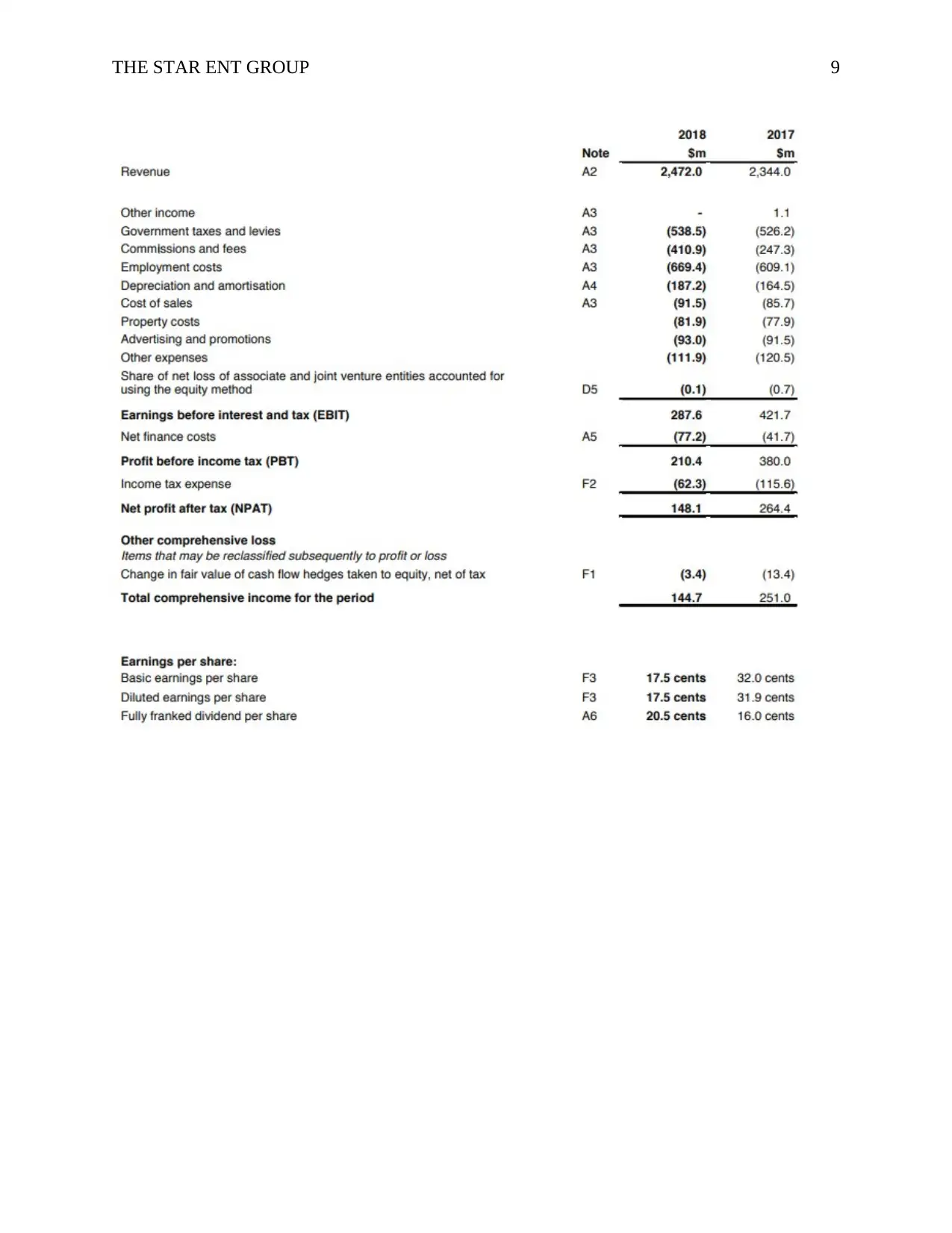
THE STAR ENT GROUP 9
⊘ This is a preview!⊘
Do you want full access?
Subscribe today to unlock all pages.

Trusted by 1+ million students worldwide
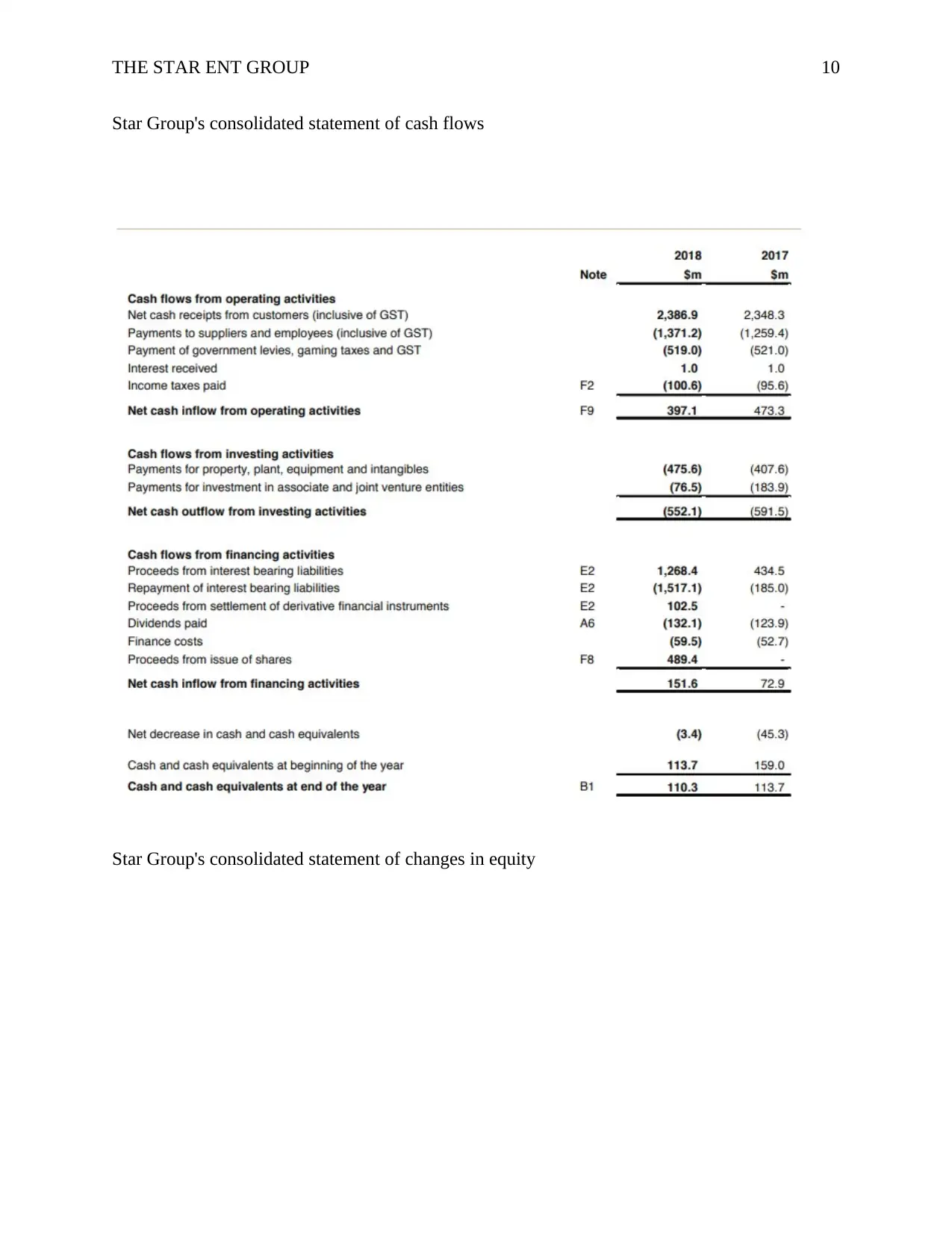
THE STAR ENT GROUP 10
Star Group's consolidated statement of cash flows
Star Group's consolidated statement of changes in equity
Star Group's consolidated statement of cash flows
Star Group's consolidated statement of changes in equity
Paraphrase This Document
Need a fresh take? Get an instant paraphrase of this document with our AI Paraphraser
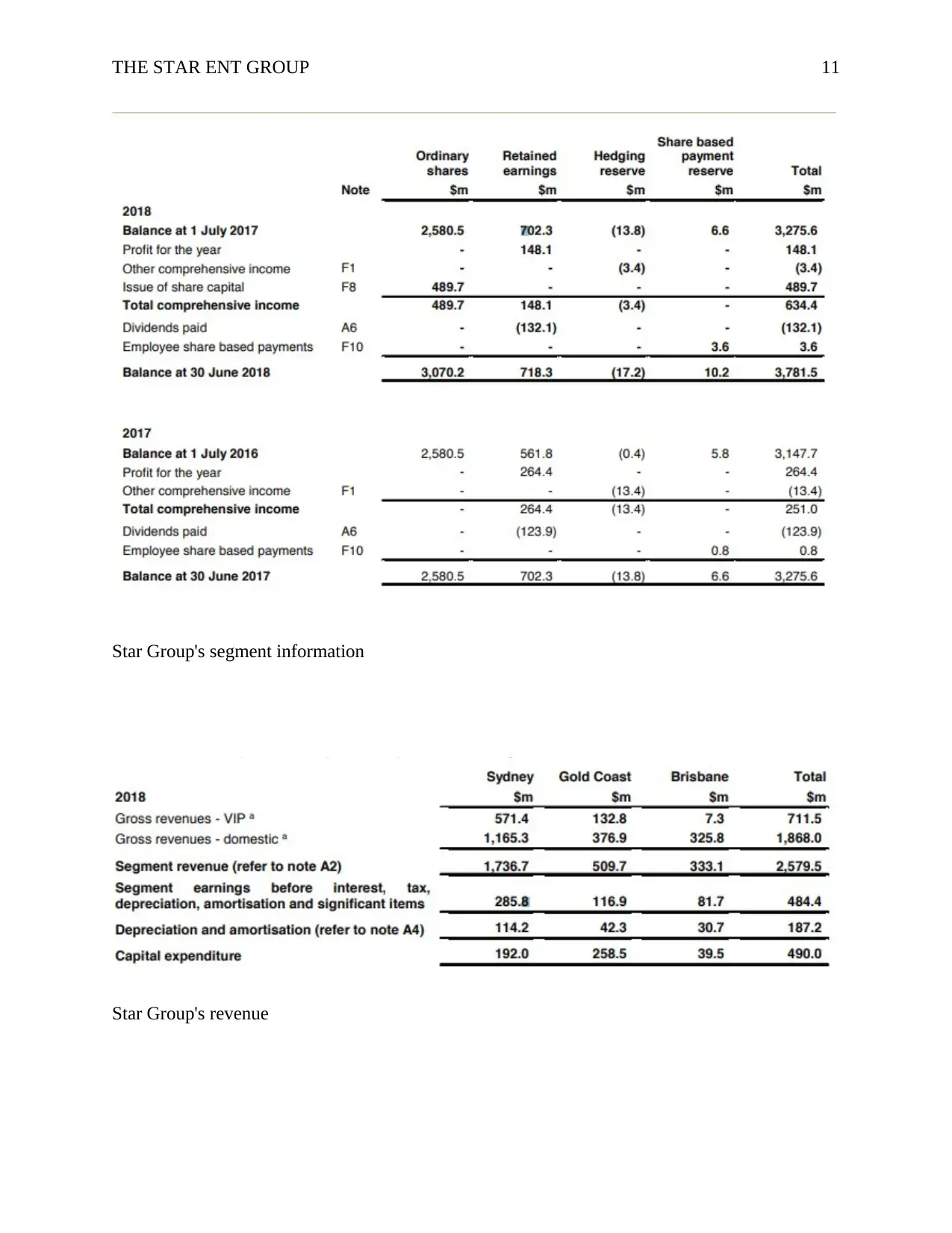
THE STAR ENT GROUP 11
Star Group's segment information
Star Group's revenue
Star Group's segment information
Star Group's revenue
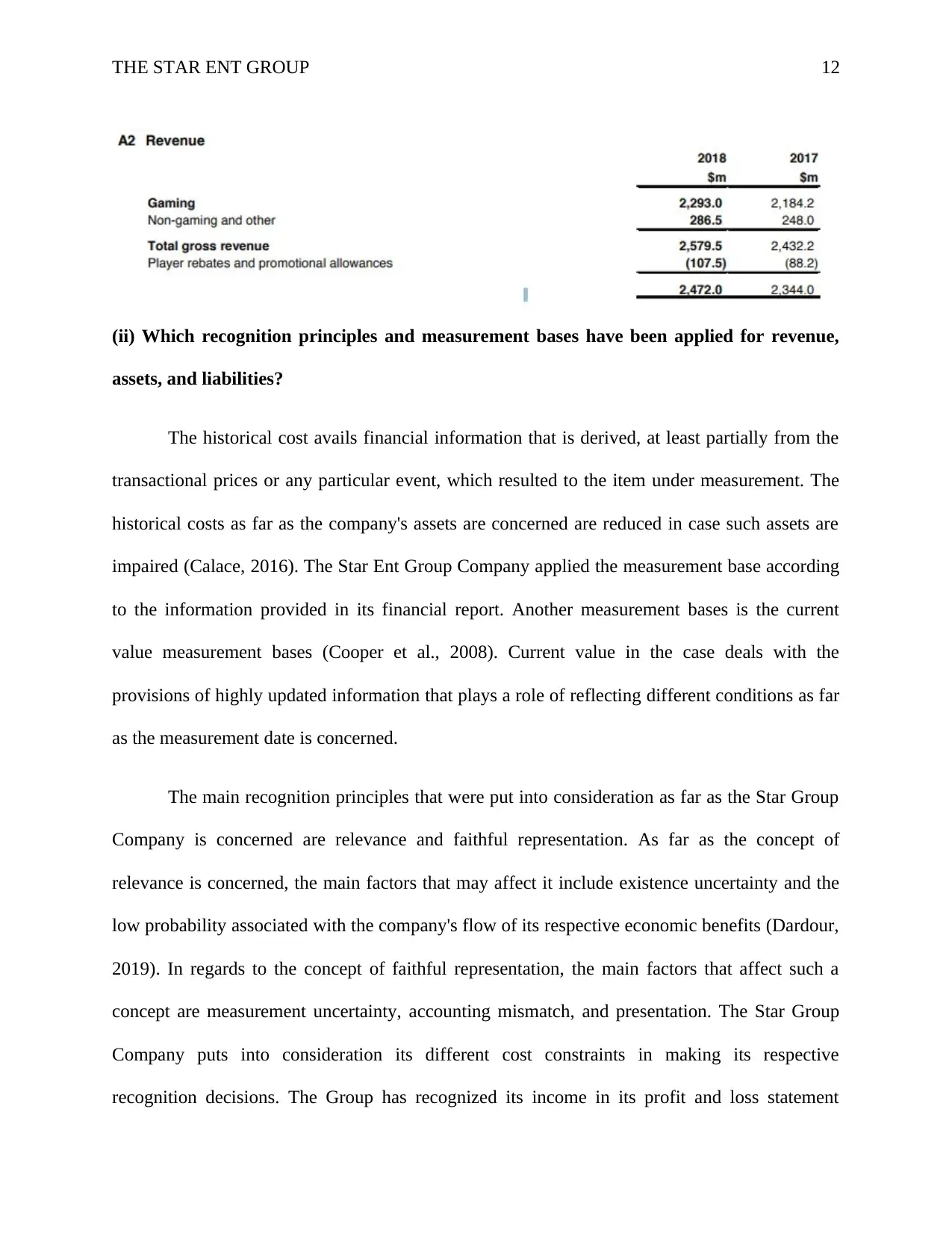
THE STAR ENT GROUP 12
(ii) Which recognition principles and measurement bases have been applied for revenue,
assets, and liabilities?
The historical cost avails financial information that is derived, at least partially from the
transactional prices or any particular event, which resulted to the item under measurement. The
historical costs as far as the company's assets are concerned are reduced in case such assets are
impaired (Calace, 2016). The Star Ent Group Company applied the measurement base according
to the information provided in its financial report. Another measurement bases is the current
value measurement bases (Cooper et al., 2008). Current value in the case deals with the
provisions of highly updated information that plays a role of reflecting different conditions as far
as the measurement date is concerned.
The main recognition principles that were put into consideration as far as the Star Group
Company is concerned are relevance and faithful representation. As far as the concept of
relevance is concerned, the main factors that may affect it include existence uncertainty and the
low probability associated with the company's flow of its respective economic benefits (Dardour,
2019). In regards to the concept of faithful representation, the main factors that affect such a
concept are measurement uncertainty, accounting mismatch, and presentation. The Star Group
Company puts into consideration its different cost constraints in making its respective
recognition decisions. The Group has recognized its income in its profit and loss statement
(ii) Which recognition principles and measurement bases have been applied for revenue,
assets, and liabilities?
The historical cost avails financial information that is derived, at least partially from the
transactional prices or any particular event, which resulted to the item under measurement. The
historical costs as far as the company's assets are concerned are reduced in case such assets are
impaired (Calace, 2016). The Star Ent Group Company applied the measurement base according
to the information provided in its financial report. Another measurement bases is the current
value measurement bases (Cooper et al., 2008). Current value in the case deals with the
provisions of highly updated information that plays a role of reflecting different conditions as far
as the measurement date is concerned.
The main recognition principles that were put into consideration as far as the Star Group
Company is concerned are relevance and faithful representation. As far as the concept of
relevance is concerned, the main factors that may affect it include existence uncertainty and the
low probability associated with the company's flow of its respective economic benefits (Dardour,
2019). In regards to the concept of faithful representation, the main factors that affect such a
concept are measurement uncertainty, accounting mismatch, and presentation. The Star Group
Company puts into consideration its different cost constraints in making its respective
recognition decisions. The Group has recognized its income in its profit and loss statement
⊘ This is a preview!⊘
Do you want full access?
Subscribe today to unlock all pages.

Trusted by 1+ million students worldwide
1 out of 29
Related Documents
Your All-in-One AI-Powered Toolkit for Academic Success.
+13062052269
info@desklib.com
Available 24*7 on WhatsApp / Email
![[object Object]](/_next/static/media/star-bottom.7253800d.svg)
Unlock your academic potential
Copyright © 2020–2025 A2Z Services. All Rights Reserved. Developed and managed by ZUCOL.




